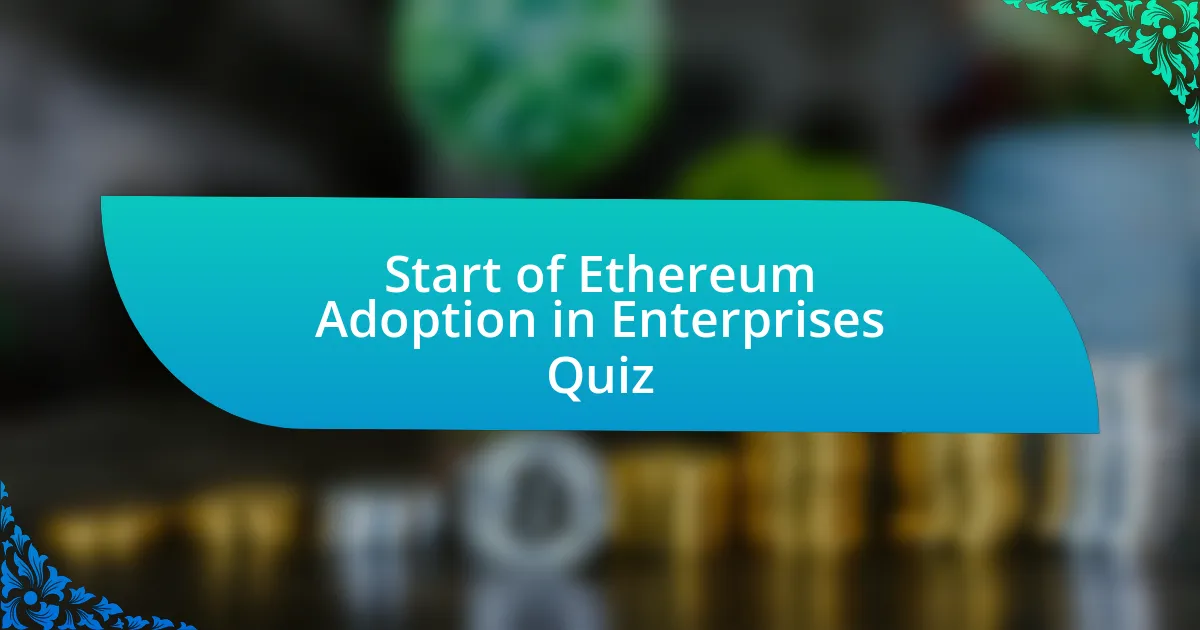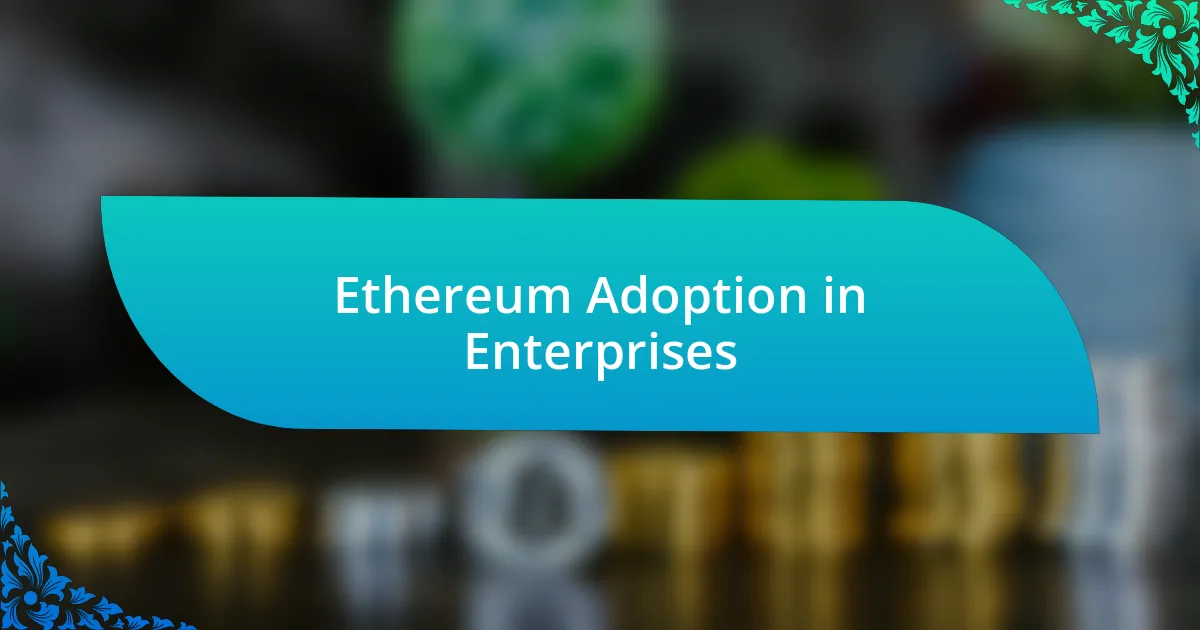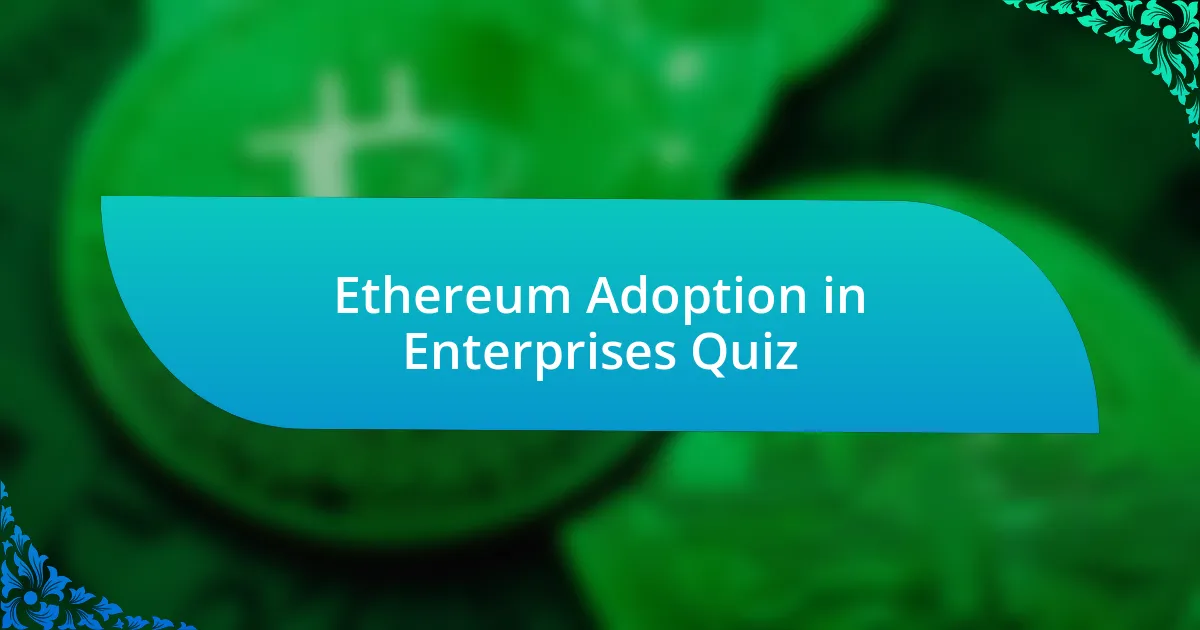
Start of Ethereum Adoption in Enterprises Quiz
1. What is Enterprise Ethereum?
- Enterprise Ethereum is a social media platform for blockchain discussions.
- Enterprise Ethereum is a cryptocurrency focused on individual investor trading.
- Enterprise Ethereum is a blockchain technology intended specifically for enterprises, built on the Ethereum blockchain.
- Enterprise Ethereum is a gaming application based on Ethereum.
2. What are the primary applications of Enterprise Ethereum?
- Supply chain management
- Online gaming platforms
- Social media networking
- Video streaming services
3. How does Enterprise Ethereum enhance supply chain management?
- It limits supply chain visibility to a single organization`s records.
- It enhances transparency, traceability, and efficiency in supply chains by enabling real-time tracking and validation of product authenticity.
- It focuses only on product marketing without logistical tracking.
- It primarily reduces the cost of manufacturing materials without improving management.
4. What is the role of smart contracts in Enterprise Ethereum?
- Smart contracts serve as a bridge to traditional banking systems for easier transactions.
- Smart contracts track employee performance and facilitate HR functions in organizations.
- Smart contracts automate various business processes, such as confirming the legitimacy of items, making payments, and monitoring contracts.
- Smart contracts create new cryptocurrencies for transaction rewards and incentives.
5. What are the benefits of using smart contracts in Enterprise Ethereum?
- Smart contracts are primarily used for social media interactions and do not affect financial transactions.
- Smart contracts lead to inefficiencies by complicating simple business processes and increasing operational costs.
- Smart contracts provide increased efficiency, security, and cost savings by automating processes and ensuring tamper-proof transactions.
- Smart contracts require extensive manual oversight to function properly and involve higher costs.
6. How does Enterprise Ethereum improve security?
- It improves security by limiting access to information within the organization only.
- It enhances security through the use of centralized databases for better control of data.
- It provides greater security than traditional commercial platforms by using blockchain technology and tamper-proof smart contracts.
- It relies on government regulations to ensure security and compliance for businesses.
7. What is the consensus algorithm used by Ethereum?
- Proof-of-Stake
- Byzantine Fault Tolerance
- Delegated Proof-of-Stake
- Proof-of-Work
8. What is the role of decentralized applications (dApps) in Enterprise Ethereum?
- dApps only serve to track product inventories.
- dApps are primarily used for gaming applications.
- dApps only enhance social media interactions.
- dApps enable new collaboration forms and secure transactions.
9. How does Enterprise Ethereum facilitate decentralized finance (DeFi)?
- It enables decentralized lending and borrowing, allowing businesses to participate in faster and more secure transactions than traditional banking systems.
- It eliminates the need for any validation of transactions, allowing instant approvals without checks.
- It centralizes financial operations, ensuring compliance with regulations for all participants.
- It restricts access to a select group of institutions, preventing broad participation in the market.
10. What is the significance of the EEA Ethereum Business Readiness Report 2023?
- The report provides a comprehensive snapshot of real-world business adoption of Ethereum, featuring insights from 260 business projects.
- The report focuses solely on technical specifications of the Ethereum blockchain and its consensus algorithms.
- The report serves as a promotional tool for Ethereum-based cryptocurrencies and investment opportunities.
- The report highlights Ethereum`s market cap and price fluctuations over the past year.
11. What are the key sections of the EEA Ethereum Business Readiness Report 2023?
- The report consists of three main sections: Executive Summary, Analysis of Blockchain Technologies, and Future Predictions.
- The report is broken up into five main sections: The Year in Business Ethereum, A Snapshot of the Use of Ethereum & EVM in Business Today, Observations and Trends, Assessing the Business Readiness of the Ethereum Ecosystem, and Conclusion.
- The report features two main sections: Company Case Studies and Technical Overview of Ethereum.
- The report includes four main sections: Market Analysis, Technical Challenges, Regulatory Insights, and User Impact.
12. What are some of the case studies included in the EEA Ethereum Business Readiness Report 2023?
- ApplePay
- Google Pay
- Roxpay
- Samsung Pay
13. Who are some of the industry experts interviewed for the EEA Ethereum Business Readiness Report 2023?
- John Smith
- Dan Heyman
- Emily Johnson
- Sarah Connor
14. What is the significance of the Enterprise Ethereum Alliance (EEA)?
- The EEA restricts businesses from using Ethereum for personal projects.
- The EEA is responsible for controlling all Ethereum transactions globally.
- The EEA focuses solely on creating a private version of Ethereum.
- The EEA enables organizations to adopt and use Ethereum technology in their daily operations.
15. How does Enterprise Ethereum improve cost savings for businesses?
- It limits cost savings by maintaining traditional methods of transaction processing without automation.
- It reduces costs by automating processes, minimizing the need for manual intervention, and enhancing efficiency through the use of smart contracts and decentralized applications.
- It increases costs by requiring more manual processing and oversight, reducing overall efficiency in businesses.
- It eliminates all costs by making transactions completely free, offering no fees for business operations.
16. What is the role of MetaMask in the context of Enterprise Ethereum?
- MetaMask is a layer-2 scaling solution for Ethereum networks.
- MetaMask is a popular browser-based Ethereum wallet that allows users to interact with decentralized applications (dApps) on the Ethereum network.
- MetaMask is a form of smart contract used for transactions on Ethereum.
- MetaMask is a mining software specifically designed for Ethereum coins.
17. What programming language is used to write smart contracts and dApps?
- Java
- C++
- Solidity
- Python
18. What is Truffle in the context of Ethereum development?
- Truffle is a popular testing and development environment for Ethereum that includes tools for creating smart contracts, dApps, automated testing, and configuring build pipelines.
- Truffle is a programming language specifically designed for Ethereum`s smart contracts.
- Truffle is a cryptocurrency trade platform for buying and selling tokens on Ethereum.
- Truffle is a graphic interface for visualizing blockchain transactions and data on Ethereum.
19. What is the functionality of Testnet in Ethereum?
- Testnet offers a marketplace for trading Ether without restrictions.
- Testnet connects only to governments for regulatory testing.
- Testnet is a network used for mining real Ether safely.
- Testnet allows developers to test their dApps and smart contracts without using real Ether.
20. Do you need to use real Ether to test dApps and smart contracts?
- Yes, you must buy Ether to test contracts.
- Yes, real Ether is necessary for all tests.
- No, free Ether can be used in test networks.
- No, only physical Ether can be used in testing.
21. How does spending work in smart contracts?
- All spending in smart contracts is free of charge.
- Gas fees apply only during the creation of the smart contract.
- Spending is tracked using a centralized ledger system.
- Spending that modifies the smart contract incurs a cost in terms of Gas.
22. What happens when the Gas runs out without the transaction being complete?
- All state changes are reversed, and the used Ethereum Gas is given to the miner.
- The transaction is automatically completed, and no gas is refunded.
- The gas amount is doubled for the next transaction attempt.
- The miner keeps all gas, and the changes made are permanent.
23. How does Bitcoin differ from Ethereum in checking the latest state?
- Bitcoin uses dynamic state verification, while Ethereum relies on static tracking methods.
- Ethereum uses mining to check state, while Bitcoin uses proof of work for confirmations.
- Bitcoin retrieves state through block headers, and Ethereum through state trees.
- Ethereum checks the latest state for account balances, while Bitcoin checks unspent transaction outputs (UTXO).
24. What is the current number of Ethereum validators?
- 750,000
- 1,500,000
- 1,000,000
- 500,000
25. What drove the significant growth in Ethereum validators?
- Decrease in smart contract usage
- Increased Ethereum gas fees
- Fluctuation in NFT popularity
- Institutional adoption in restaking sectors
26. What is the total amount of staked Ether (ETH)?
- 34.7 million
- 10 million
- 25 million
- 50 million
27. What contributed to the growth in staked Ether?
- The growth was attributed to the Shanghai upgrade and the approval of Ethereum futures exchange-traded funds (ETFs).
- The growth stemmed from the decline of legacy financial systems and their inefficiencies.
- The growth was driven by the rise of non-fungible tokens (NFTs) and their market demand.
- The growth resulted from the increase in Bitcoin value and popularity.
28. What is the significance of the Shanghai upgrade in Ethereum?
- The Shanghai upgrade increased the block size limit for transactions.
- The Shanghai upgrade enabled participants to unstake their Ether.
- The Shanghai upgrade integrated privacy features for transactions.
- The Shanghai upgrade introduced a new consensus mechanism.
29. How does Enterprise Ethereum enhance transparency in supply chains?
- It enhances transparency by enabling real-time tracking and validation of product authenticity through blockchain technology.
- It increases sales volume by promoting products through targeted advertising on social media platforms.
- It reduces transportation costs by providing discounts on logistics services for participating businesses.
- It improves inventory management by automating stock replenishment processes through AI algorithms.
30. What is the role of interoperability in Enterprise Ethereum?
- Interoperability increases the complexity of Enterprise Ethereum applications.
- Interoperability limits Enterprise Ethereum to only private networks.
- Interoperability makes Enterprise Ethereum dependent on third-party software.
- Interoperability allows Enterprise Ethereum to seamlessly interact with the wider Ethereum ecosystem.

Congratulations! You’ve Successfully Completed the Quiz
Thank you for taking the time to complete our quiz on Ethereum Adoption in Enterprises. We hope you found the questions engaging and thought-provoking. Through this quiz, participants learned about the various ways enterprises are integrating Ethereum into their operations. This includes understanding its potential for enhancing transparency, security, and efficiency in business processes.
You’ve explored the challenges and benefits that come with adopting this innovative technology. Understanding these aspects is crucial for anyone interested in the future of blockchain and its role in enterprise solutions. We trust that you now have a clearer picture of how Ethereum can impact different industries.
If you want to delve deeper into the subject, we invite you to check out the next section on this page. It offers comprehensive information on Ethereum Adoption in Enterprises. This section will expand your knowledge and provide valuable insights for better understanding this transformative technology.

Ethereum Adoption in Enterprises
Understanding Ethereum and its Enterprise Applications
Ethereum is a decentralized blockchain platform that enables the creation of smart contracts and decentralized applications (dApps). In enterprise contexts, Ethereum provides solutions for automation, transparency, and security. Companies leverage Ethereum to streamline processes, reduce operational costs, and improve data integrity. This adoption is propelled by Ethereum’s robust network and the flexibility it offers for various business needs.
Advantages of Ethereum Adoption in Enterprises
Enterprises adopt Ethereum for several key advantages. These include enhanced security through cryptographic methods, reduced transaction costs via peer-to-peer transactions, and improved transparency, allowing all participants to view transaction history. Furthermore, smart contracts automate operations, minimizing human errors and enriching trust among parties. These benefits drive enterprises toward Ethereum for innovative solutions.
Industry Use Cases of Ethereum
Several industries demonstrate notable Ethereum adoption. In finance, blockchain technology facilitates secure transactions and asset tokenization. The supply chain industry uses Ethereum to enhance traceability and efficiency, while the healthcare sector secures patient data through decentralized record keeping. Real estate employs Ethereum for property tokenization, simplifying transactions and legal processes. These use cases showcase Ethereum’s versatility across sectors.
Challenges to Ethereum Adoption in Enterprises
Despite its benefits, Ethereum faces challenges in enterprise adoption. Scalability remains a significant issue, as high transaction volumes can lead to congestion and increased fees. Regulatory uncertainties also hinder widespread implementation. Moreover, enterprises must invest in training and infrastructure to transition effectively to blockchain solutions. Addressing these obstacles is essential for broader Ethereum integration in business processes.
The Future of Ethereum in Enterprise Adoption
The future of Ethereum in enterprises looks promising. Continuous improvements in scalability and transaction speeds are underway, with upgrades like Ethereum 2.0 aimed at enhancing network efficiency. Increased interest from corporations and partnerships within the ecosystem signal growing confidence in this platform. As regulations evolve and technologies mature, more enterprises are likely to embrace Ethereum solutions for their operations.
What is Ethereum Adoption in Enterprises?
Ethereum adoption in enterprises refers to the integration and use of the Ethereum blockchain technology by businesses to enhance operations, streamline processes, and improve transparency. Companies leverage Ethereum for smart contracts, decentralized applications, and asset management, promoting efficiency. A clear indicator of this trend is the increasing number of Fortune 500 companies exploring blockchain solutions based on Ethereum for supply chain management and financial services.
How are enterprises adopting Ethereum?
Enterprises adopt Ethereum by implementing decentralized applications (dApps) and smart contracts tailored to specific business needs. They often start pilot projects to test the technology’s capabilities. Many enterprises join consortiums like the Enterprise Ethereum Alliance (EEA), which offers resources and frameworks to accelerate adoption. For instance, companies such as Microsoft and IBM have developed blockchain solutions using Ethereum to facilitate better data sharing.
Where is Ethereum being adopted in the enterprise sector?
Ethereum is being adopted across various sectors, including finance, supply chain, healthcare, and logistics. In finance, companies use Ethereum for tokenization of assets and decentralized finance (DeFi) applications. In supply chain management, firms utilize Ethereum for tracking goods and ensuring authenticity. Notable examples are VeChain partnering with major companies to enhance product tracking and traceability.
When did enterprises start adopting Ethereum technologies?
Enterprises began adopting Ethereum technologies around 2017, coinciding with the rise of Initial Coin Offerings (ICOs) and blockchain interest. The formation of the Enterprise Ethereum Alliance (EEA) in February 2017 accelerated this process by bringing together companies to focus on Ethereum as a business solution. Since then, numerous enterprises have progressively integrated Ethereum-based solutions into their operations.
Who are the key players in Ethereum adoption among enterprises?
Key players in Ethereum adoption include large corporations such as Microsoft, JPMorgan Chase, and Intel, which are exploring and implementing Ethereum-based solutions. Additionally, startups and technology firms like ConsenSys are leading innovation in this space by providing tools and frameworks for enterprise adoption. Collaborative efforts among these entities facilitate a broader adoption of Ethereum technologies across industries.

